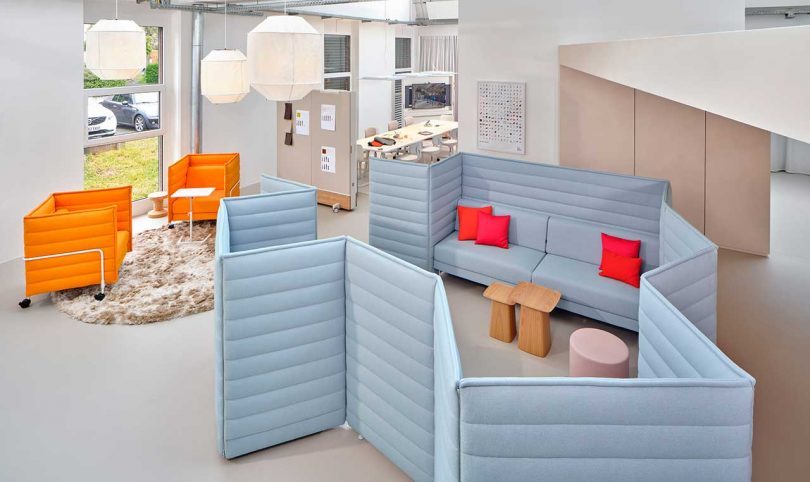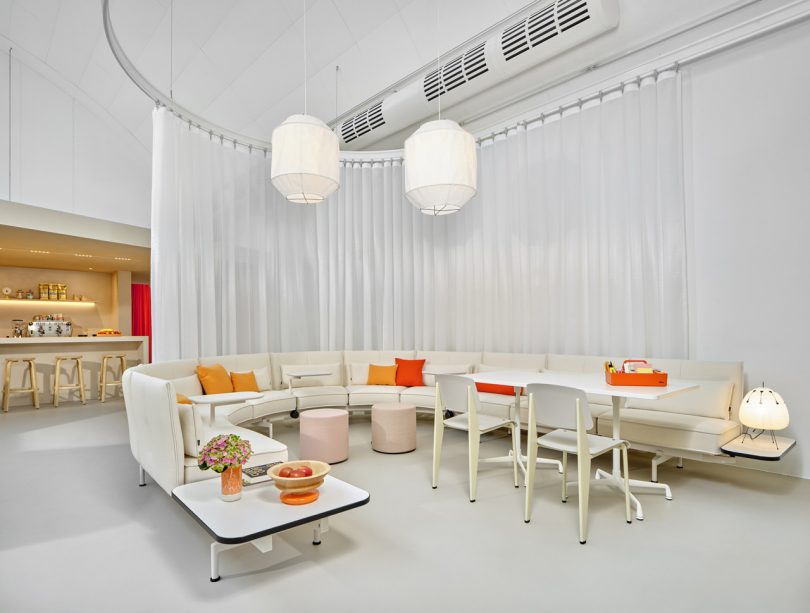As the semblance of life pre-pandemic begins to boomerang back into our lives, so too does our work schedules requiring a return to the workplace. But these times beg the question: Is yesterday’s workplace suitable for today’s needs, especially in response to the numerous things we’ve learned – and now value – after more than a year of working from home? Swiss furniture company Vitra proposes it can be with the Vitra Club Office.
The Vitra Club Office is the furnishing brand’s response developed at the company’s headquarters in Birsfelden near Basel for its own Research & Design team – an attempt to reinvent the office with an emphasis upon camaraderie and collaboration, shaped by feedback and observations learned from working from home during the pandemic.
“Those who choose to go to the office today and in the future do so consciously – to meet colleagues and experience a sense of belonging and appreciation,” says Nora Fehlbaum, CEO of Vitra. “The common mission and organizational purpose should be perceptible. Consequently, it must be more than just a place of work. Today, an office needs to provide added value. If an office has no character and colleagues there hide from one another, it’s better to spare the commute and stay at home.”
In other words, the Vitra Club Office is intended to inspire an ideal, one purporting to deliver a more convivial and easily adaptable atmosphere where people genuinely want to work from, inviting “spontaneous exchange of knowledge and insights,” as described by Christian Grosen, Chief Design Officer at Vitra, whose team currently occupies the Club Office.
One often never utters “I’ve got to go to the office” with the same enthusiasm as, “let’s hit up the club!”. The Vitra Club Office is designed to alter perceptions and also the dynamic of the workplace, emphasizing how furnishings and the atmosphere it shapes can affect productivity, attitude and general employee happiness.
Divided into three distinct zones, the Vitra Club Office’s first area is a public area furnished comfortably with seating imagined to spur on spontaneous meetings and informal collaboration. Furniture like the brand’s Alcove [shown below] developed in collaboration with Ronan and Erwan Bouroullec offer the ability to use an integrated soft partition “wall” which can buffer sounds from entering or escaping a conversation, while the Soft Work sofa system is more conducive to open-air conversations. Functionally adaptable storage and organizational forms like the Dancing Wall designed by Stephan Hürlemann lend an additional layer of functional flexibility.
The second adds a modest amount of privacy, one optimized for break out and more formal collaboration with flexibility in mind. Furnishings like Vitra’s Dancing Wall, Stool Tool and Tip Ton are all easily moveable, permitting the flexibility to accommodate for team projects and brainstorming.
And finally the third is designed to offer workers a space for solitude and privacy sheltered from disruptions, taking on the semblance and best attributes of the home office.
One hopes to see more companies taking a flexible approach to working from the office in relation to working from home, permitting employees to work within a setting not only optimal for productivity, but long term health and happiness. The Vitra Club Office might offer the framework of an office that feels a little more like home, underlining the benefits of working together and justifying the commute that comes along with it.
Photos by Eduardo Perez for Vitra.
from WordPress https://connorrenwickblog.wordpress.com/2021/07/07/vitra-club-office-leans-into-the-collaborative-value-of-working-together/










No comments:
Post a Comment